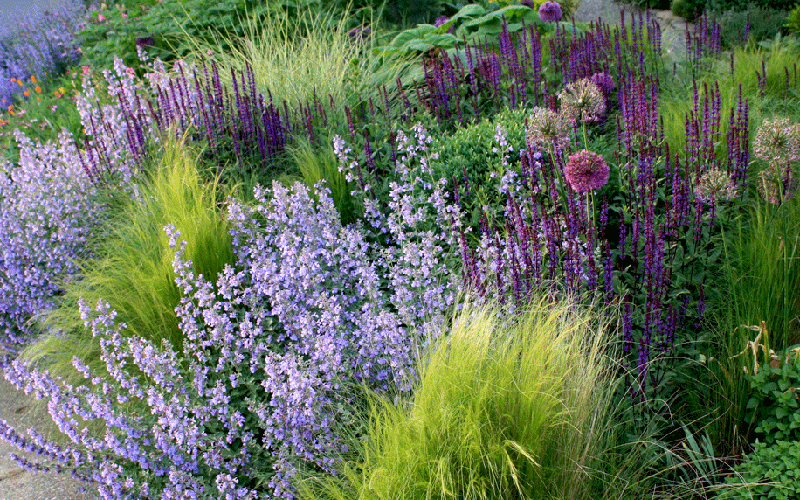Professional Practice
Applying Ecological Design: Supporting Pollinators
 Perennial garden by Thomas Rainer, ASLA / Pollinator Paradise Project
Perennial garden by Thomas Rainer, ASLA / Pollinator Paradise ProjectPlants play a crucial role in creating wildlife habitat for a range of birds, insects, and herbivores. Honey bees are an essential pollinator and have faced precipitous decline due in part to colony collapse disorder. Bats, another important pollinator, have also faced critical population declines in recent years due to the disease White Nose Syndrome. Pollinators are at further risk with the continued use of pesticides and other chemicals, as well as habitat loss.
Bees, bats, and a number of other animals, including birds, beetles, and butterflies, play an important role in keeping ecosystems functioning, and provide vital services such as pollination. According to the Natural Resources Defense Council, these cross-pollinating animals help support 30 percent of the world’s crops and enable 90 percent of wild plants to thrive.
There are several simple and cost-effective ways to support pollinator population growth. Homeowners can grow plants that attract pollinators through their nectar and pollen. Homeowners can stop using pesticides and herbicides. Homeowners can also support habitats through urban and residential beekeeping systems and by building bat houses.
Organizations
American Beekeeping Federation
Back Yard Beekeepers Association
Pollinator Partnership
Resources
Planting Guides, Pollinator Partnership
Planting Guides, Bee City USA
Bee Culture: The Magazine of American Beekeeping
The Incredible Value of Honey Bees, The Dirt, American Society of Landscape Architects
Place-making for Bees, The Dirt, American Society of Landscape Architects
Design with Every Bee in Mind, The Dirt, American Society of Landscape Architects
Are Urban Bats the Future?, The Dirt, American Society of Landscape Architects
21 Best Plants for Pollinators, Sunset
Policies to Protect Pollinators, Berkeley Food Institute
Pollinator Friendly Practices, North American Pollinator Protection Campaign
Factsheet: Chesapeake Bay Watershed: Native Herbs & Vines, North American Pollinator Protection Campaign
Factsheet: Chesapeake Bay Watershed: Native Shrubs & Trees, North American Pollinator Protection Campaign
A Tower Made for Bats, The Dirt, American Society of Landscape Architects
Pollinators in the City, The Field, American Society of Landscape Architects
Research
“The Bee-Friendly Garden: Design an Abundant, Flower-Filled Yard that Nurtures Bees and Supports Biodiversity,” Kate Frey, Gretchen LeBuhn, Leslie Lindell, Ten Speed Press, 2016
"Insects and Gardens: In Pursuit of a Garden Ecology," Eric Grissell and Carl Goodpasture. Timber Press, 2006
"Pollinator Conservation Handbook: A Guide to Understanding, Protecting, and Providing Habitat for Native Pollinator Insects," Matthew Shephard, Stephen L. Buchmann, Mace Vaughan, and Scott Hoffman Black. Xerxes Society, 2003
“The Beekeeper’s Handbook,” Diana Sammataro, Alphonse Avitabile, Dewey M. Caron, Comstock Publishing Associates, 2011
“Bees in Your Backyard: A Guide to North America’s Bees,” Joseph S. Wilson, Olivia J. Messinger Carril, Princeton University Press, 2015
“Gardening for Birds: Create a Bird-Friendly Habitat in Your Backyard,” Julie Zickefoose, Skyhorse Publishing, 2016
Government Resources
Pollinators and Ecosystem Services, National Biological Information Infrastructure, U.S. Geological Survey
Trees, Pollinators and Responsible Pesticide Use for Minnesota’s Woodlands, Minnesota Department of Natural Resources
Pollinators, U.S. Fish and Wildlife Services
National Strategy to Promote the Health of Honey Bees and Other Pollinators, Pollinator Health Task Force, The White House
Using Native Plants to Attract Butterflies and Clearwing Moths in the Washington, D.C. Area and Virginia, Fairfax County Park Authority
Projects
Kronish House, Beverly Hills, California
Marmol Radziner
Private Residence/Landscape Restoration, Rowena, Oregon
Koch Landscape Architecture
The Restoring of a Montane Landscape, Rocky Mountains, Colorado
Design Workshop, Inc.